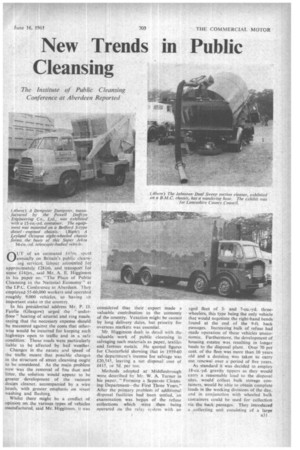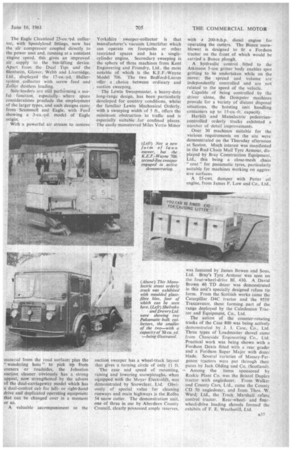New Trends in Public Cleansing
Page 65

Page 66

Page 71

If you've noticed an error in this article please click here to report it so we can fix it.
The .Institute of Public Cleansing Conference at Aberdeen Reported OUT of an estimated t45m. spent annually on Britain's public cleansing services', labour accounted for approximately f281th. and transport for some 114-1m., said Mr. A. E. Higginson in his paper on "The Place of Public Cleansing in the National Economy" at the I.P.C. Conference at Aberdeen. They employed 55-60,000 workers and operated roughly. 9,000 vehicles, so having an important stake in the country.
In his presidential address Mr. P. D. Fairlie (Glasgow) urged the " underfloor " heating of arterial and ring roads. saying that the necessary expense should be measured against the costs that otherwise would be incurred for keeping such highways open to traffic and in a safe condition. Those roads were particularly liable to be affected by bad weather.
Changes in the nature and speed of the traffic meant that possible changes in the structure of street cleansing ought to be considered. As the main problem now was the removal of fine dust and litter, the solution would appear to be greater development of the vacuum design cleaner, accompanied by a wire brush, with greater emphasis on street washing and flushing.
Whilst there might be a conflict of opinion on the various types of vehicles manufactured, said Mr. Higginson, it was considered that their export made a valuable contribution to the economy of the country. Vexation might be caused by long delivery dates, but priority far overseas markets was essential.
Mr. Higginson dealt in detail with the valuable work of public cleansing in salvaging such materials as paper, textiles and ferrous metals, He quoted figures for Chesterfield showing that in 1959-60 the department's income for salvage was £20,545. leaving a net disposal cost of f415, or 5d. per ton.
Methods adopted at Middlesbrough were described by Mr. W. A. Turner in his paper, "Forming a Separate Cleansing Department—the First Three Years." After the primary problem of additional disposal facilities had been settled, an examination was begun of the refuse collections which Were then being operated on the t'ela s stem with an
aged fleet of 5and 7-cu.-yd. threewheelers, this type being the only vehicle that would negotiate the right-hand bends' found at the end of the 9-ft. back passages. Increasing bulk of refuse had made operation of these vehicles uneconomic. Furthermore, the development of housing estates was resulting in longer hauls to the disposal plant. Over 70 per cent. of the fleet was more than 10 years old and a decision was taken to carry out renewal over a period of five years.
As standard it was decided to employ 18-cu.-yd. gravity tippers as they would carry a reasonable load to the disposal sites, would collect hulk storage containers. would be able to obtain complete loads in the working divisions of the day, and in conjunction with wheeled bulk containers could be used for collection via the back passages. They introduced a collecting unit consisting of a large
capacity vehicle, assisted by two-wheeled bulk containers. The latter were taken into the backs and dustbin contents emptied into them, the big containers then being transferred mechanically into the vehicle.
Static bulk containers were installed on hire at shops, offices, factories, schools and flats. Here a collecting vehicle with driver and mate achieved an output equal to a five-man team serving domestic premises.
Since early 1958 all street sweeping had been carried out between 6 a.m. and 2 p.m., operations first being concentrated on the busy central areas which were scheduled for completion by ..8.30 a.m., manual sweepers thin being dispersed to less busy streets and suburbs.
Vehicles had been put on a preventive maintenance scheme and every three months were withdrawn for thorough inspection. In particular, items were noted that should be remedied in workshops or would require attention on -the next occasion.
The object of cleansing was different from that of industry, said Mr. C. Cockcroft (Blackburn), who suggested that the first requirement was the most hygienic collection system, the roost economic methods coming next. Giving examples of some retrograde suggestions that had been made, Mr. F. J. Shults (Tottenham) said they wanted work study experts who were also experts in cleansing. Cllr. W. Fletcher (Salford) considered that industry was going away from time and motion study. The most productive and satisfactory system was where men worked together as a team and shared the rewards.
In the discussion which followed the paper on handling of trade refuse, Mr. C. A. Wood (Newcastle-under-Lyme) urged that small traders. and particularly food traders, should not carry waste materials to the disposal point in their own vehicles. From the health angle this duty should be accepted by the cleansing department.
Wednesday's vehicle parade, which was
carried through with great slickness, brought out only a small minority of bodies that merely carry refuse. Today the vast majority of new machines in this sphere have some specialist function, if only that of packing up loads that continue to increase in bulk whilst decreasing in density. In this connection it was interesting to hear that the Walker and County Cars, Ltd., M.P.L. static-compaction system, seen in model form last year, will soon be an operational fact. The potentialities of suction cleaning rightly continue to attract attention, although for some the economics require careful consideration.
In addition to the 50-cu.-yd. SD Pakamatic, Shelvoke and Drewry, Ltd., demonstrated a similar machine with a 30-cu.-yd. body, specially intended for the clearance of storage containers from flats and other large premises. These are rear tippers with provision for airoperated hygienic shutters, At full capacity the big brother will carry 7 tons of medium household refuse, compression being by direct thrust.
As explained in The Commercial Motor preview; the main development with the Gibson products concerns improvements to the hydraulic system, controls for which can be located either in the cab or at the rear of the body. A new Gibson experimental design, featuring dustless loading, was brought to Aberdeen for inspection by the experts.
Largest of the Karrier offering was the Blenheim 22 30-cu.-yd. compressor which, it was pointed out, will work through a normal shift without discharge.
Three representatives of the wellknown Dennis Pax series included a Paxit II destined for Ceylon which, like the other two, featured rustIess lightmetal panelling. Walkers, to whom reference has already been made, were showing a 34-cu.-yd. Super-Jekta on a Leyland Octopus chassis for bulk disposal work. Apart from their own demonstration Eagle had bodies on imhicles shown by Vauxhall and Ford, notably the Compressmore, which now has hydraulic pipelines and controls grouped so as to give easier maintenance. The Eagle Cleanload 25-cu.-yd. collector, with Speedyload fittings, now has the air compressor coupled directly to the power unit and, running at a constant engine speed, this gives an improved air supply to the bin-lifting device. Apart from the Dual Tips and the Blenheim, Glover, Webb and Liversidge, Ltd., displayed the 17-cu.-yd. Hallersystem collector with screw feed and Zoller dustless loading. Side-loaders are still performing a useful function, especially where space considerations preclude the employment of the larger types, and such designs came from Scarnmell and Eagle, with Ford' showing a 3-cu.-yd. model of Eagle origin.
With a powerful air stream to remove
material from the road surface,' plus the "wandering hose" to pick up from corners or roadsides, the Johnston suction cleaner obviously has a strong appeal, now strengthened by the advent of the dual-carriageway model which has a dual-control cab for leftor right-hand drive and duplicated operating equipment that can be changed over in a moment or so.
A valuable accompaniment to the Yorkshire sweeper-collector is that manufacturer's vacuum Litterlifter which can operate on footpaths or other restricted spaces and has a singlecylinder engine. Secondary sweeping is the sphere of three machines from Kent Engineering and Foundry, Ltd., the most notable of which is the K.E.F.-Wayne Model 706. The two Bedford-Lacres offer a choice between ordinary and suction sweeping.
The Lewin Sweepmaster, a heavy-duty long-range design, has been particularly developed for country conditions, whilst the familiar Lewin Mechanical Orderly. with a sweeping width of 5 ft.. offers the minimum obstruction to traffic and is especially suitable for confined places. The easily manceuvred Miles Verro Minor suction sweeper has a wheel-track layout that gives a turning circle of only 11 ft.
The ease and speed of mounting, raising and lowering snowploughs, when equipped with the Meyer Electrolift, was demonstrated by Snowclear, Ltd. Obviously of special value for cleaning runways and main highways is the Rolba 54 snow cutter. The demonstration unit, one of three in use by Aberdeen County Council, clearly possessed ample reserves,
with a 200-b.h.p. diesel engine for operating the cutters. The Bunce snowblower is designed to fit a Fordson tractor on the front of which would be carried a Bunce plough.
A hydraulic control fitted to the Atkinson 5-ton griller body enables spot gritting to be undertaken while on the move; the spread and volume are independently controlled and are not related to the speed of the vehicle. .
Capable of being controlled by the driver alone, the Dempster machines provide for a variety of distant disposal situations, the hoisting unit handling containers up to 15-cu.-ft. capacity.
Harbilt and Manulectric pedestriancontrolled orderly trucks exhibited a number of detail improvements.
Over 30 machines suitable for the various requirements on the site were demonstrated on the Thursday afternoon at Seaton. Much interest was manifested in the Rud Chain Mail Tyre Armour, displayed by Bray Construction Equipment, Ltd., this being a close-mesh chain " coat " for pneumatic tyres, particularly suitable for machines working on aggressive surfaces.
A 15-cwt. dumper with Petter oil engine, from James F. Low and Co., Ltd., was featured by James Bowen and Sons, Ltd. Bray's Tyre Armour was seen on the four-wheel-drive BL 430. A David Brown 40 TD dozer was demonstrated in this unit's specially designed refuse tip form. From the Scottish works came the Caterpillar D4C tractor and the 955F Traxcavator, these forming part of the range deployed by the Caledonian Tractor and Equipment, Co., Ltd.
The action of the counter-rotating tracks of the Case 800 was being actively demonstrated by J. I. Case, Co., Ltd. Three types of • Loadmaster shovel came from Chaseside Engineering Co., Ltd. Practical work was being shown with a Fordson Dexta fitted with a rear grader and a Fordson Super Major with dozer blade. Several varieties of Massey-Ferguson tractors were put through their paces by Jack Olding and Co. (Scotland).
• Among the items sponsored by Reek ie Plant Co. was the Bristol Duplex tractor with angledozer. From Walker and County Cars, Ltd., came the County CD 50 angledozer, and from Thos. W. Ward; Ltd., the Track Marshall refuse control tractor. Rear-wheeland fourwheel-drive loading shovels formed the exhibits of F. E. Weatherill, Ltd.




















































































































